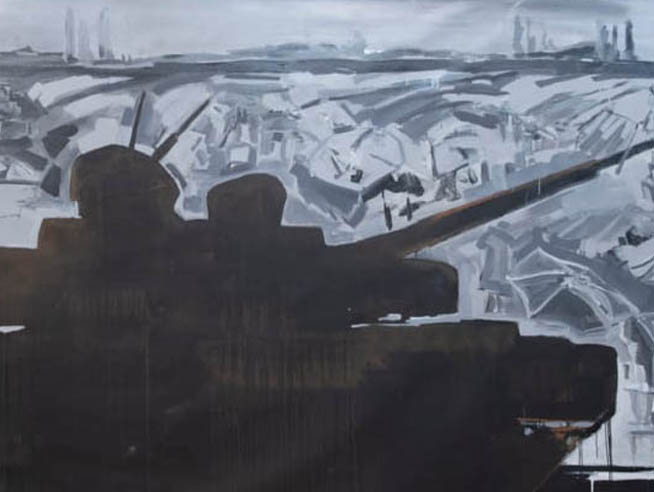Exhibitions

Left Bank( (Hagada Hasmalit)) Gallery Exhibition “Wearing a Tiger Skin”
Tatia Gogati Shohet’s new exhibition consists of three parts, apparently different from each other in content and medium. On one wall there is a large painting in which a huge silhouette of a tank threatens the crowd of people in front of it; On the opposite wall hangs a row of portraits on yellowed papers, all depicting the same figure; and in the other end of this wall – a triptych depicting a landscape in the south of Mount Hebron. As in the artist’s previous exhibitions, where scenes from masterpieces of Georgian cinema resonate alongside memories and experiences from her childhood in Georgia, here too we find such echoes, this time from Tengiz Abuladze’s film “The Wishing Tree” (1976). In the shadow of the Russian invasion of Ukraine, which has been going on for about two months and is causing devastating damage and killing throughout the country, Gogati Shohet recalls the Russia-Georgia war in 2008, as well as the never-ending conflict here in our region, and in general the futility of wars.
Abuladze’s film functions as a bottom layer for the works in the exhibition, a kind of groundwater layer into which images, memories, horrors and longings for Georgia, the artist’s homeland, sink or float above. In the film, comic characters are presented alongside tragic ones, reminiscent of the characters of Fellini and Kusturica – characters of seekers and wish-chasers: goldfish, magic stones, golden eggs, wish trees, and especially a great storm that will bring an end to the rule of the tsars and build a new, just, and free world. Another creator whose specter is seemingly present in the exhibition is Shota Rustaveli, a 12th century Georgian poet who left his country and retired to live as a monk in Jerusalem. Abuladze studied theater at the school named after Shota Rustaveli, and his film “The Wishing Tree” won the Rustaveli prize (the poet is mentioned in the film more than once). The title of Rustaveli’s famous poem “The Knight in the Panther’s Skin ” inspired the name of the exhibition.
The works in the exhibition were created during the last months, in the shadow of the war in Ukraine, and the name of the exhibition alludes, among other things (and perhaps mainly), to Putin’s machismo and brutal display of muscles. But the criticism embedded in the exhibition is broader, as above mentioned, and refers also to the incessant killing in our private conflict. The most prominent painting in the exhibition reminds us of the Russian invasion, and the triptych painting is based on a photograph from the south of Mount Hebron, the place where a Palestinian was seriously injured trying to prevent IDF soldiers from confiscating a generator belonging to his family. The artist sees in this painting the landscapes of her childhood in Georgia, and it indeed corresponds with scenes from Abuladze’s film – the view from the shack of the seductive woman to the outside, or the view from inside the church, where Gedia’s mother prays for her son’s return. The series of drawings on newsprint, also inspired by a character from the film, symbolizes the absurdity and helplessness that accompanies every war. The drawings are based on the character of the grandmother Maradia in the film: at the sight of her granddaughter Marita lying lifeless on the muddy ground, the grandmother is unable to get a word out of her mouth, and only her hands speak, wondering, refusing to believe; perhaps turning to the Holy Mary, perhaps to her granddaughter, perhaps to the crowd of people who caused her death. This silent monologue was translated by Gogati Shohet into dozens of drawings (only a part of which is shown here) in each of which there is a different movement of the hands.
The scenes in the film, both the funny and the tragic, are wrapped in great beauty. The concept of beauty preoccupies Tatia Gogati Shohet in most of her works, even if it is often hidden under a layer of black paint. The closing lines of the film may characterize the mindset of the artist these days, and perhaps in general: “Where does beauty come into the world? And where does it go? Or maybe it just hides its face from us for a while?”
Ilan Wizgan, May 2022